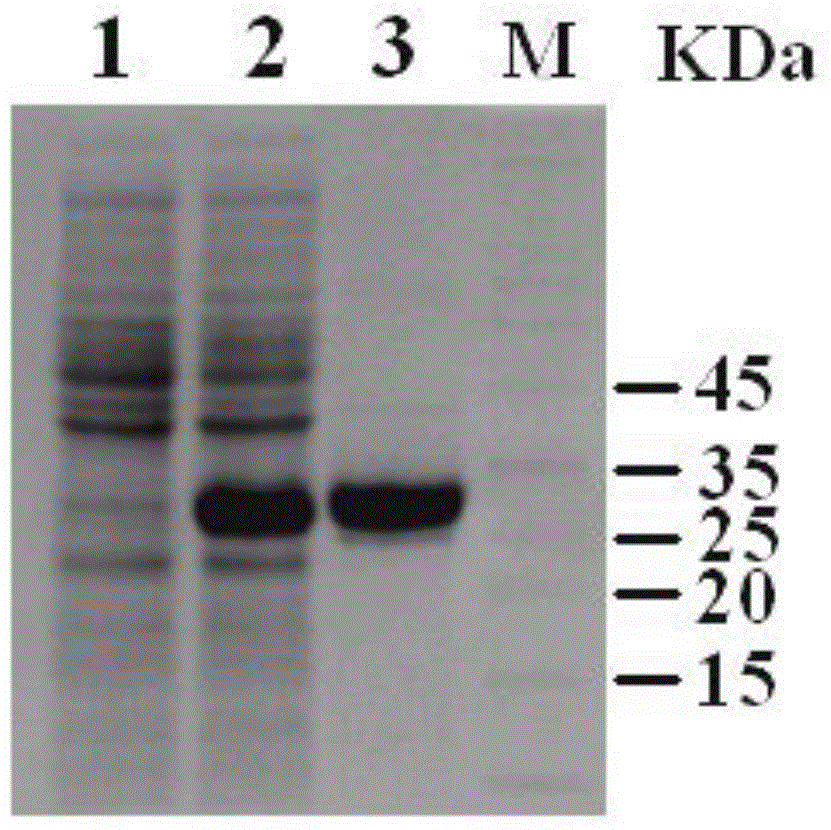Fusion protein gold nano-cluster complex Au@(gCTX)NCs and preparation method and application thereof
A technology of fusion protein and gold nanoclusters, applied in the field of genetic engineering, to achieve the effects of excellent fluorescence properties, green process, and high fluorescence stability
- Summary
- Abstract
- Description
- Claims
- Application Information
AI Technical Summary
Problems solved by technology
Method used
Image
Examples
Embodiment 1
[0076] Example 1: Molecular design of gCTX protein sequence
[0077] The primary amino acid sequence of the CTX polypeptide obtained by searching the NCBI database is: MCMPCFTTDHQMARKCDDCCGGKGRGKCYGPQCLCR. According to the primary amino acid sequence of the CTX polypeptide, based on the consideration of the efficient recombinant expression and purification of the scorpion venom polypeptide, it was fused and expressed with the GST protein tag. On this basis, the applicant molecule designed the tumor-targeting protein GST-CTX ( gCTX), whose sequence is the amino acid sequence shown in SEQ ID NO. 1, and the nucleotide coding sequence is shown in SEQ ID NO. 2. Insert the nucleotide coding sequence into the BamH1 and Xho1 sites of the pGEX-6p-1 vector to obtain recombinant expression Plasmid pGEX-CT.
Embodiment 2
[0078] Example 2: Preparation of genetically engineered bacteria Rosetta (DE3) (pGEX-CTX) and expression and affinity chromatography of recombinant chlorotoxin protein (gCTX)
[0079] The recombinant expression plasmid pGEX-CT was transformed into the prepared E. coli competent Rosetta (DE3) cells (see the second edition of "Molecular Cloning" for the method). The plate is LB / AP+agar plate. Monoclonal clones were selected to obtain genetically engineered strain Rosetta (DE3) (KCT-W1 / pGEX-6p-1). Inoculate the clones (recombinant Escherichia coli Rossetta(DE3) / CTX / pGEX-6p-1) in LB liquid medium containing ampicillin at a ratio of 1:100, and add IPTG (final concentration) when cultured at 37℃ to OD6000.8 0.1mM) to induce the culture, and then incubate the culture at 28°C for 4 hours to express the target gene (see figure 1 ). Concentrate the induced culture 50 times, ultrasonically break the cells (80HZ, 30 seconds / time, until the culture becomes clear), centrifuge at 12000rpm for...
Embodiment 3
[0080] Example 3: Concentration desalting and HPLC separation of recombinant gCTX protein
[0081] The fusion protein gCTX eluted in Example 7 was centrifuged and desalted through a 15ml 10KDa ultrafiltration tube (Millipore, Centricon, USA) at a centrifugal speed of 3500rpm / min and a temperature of 4°C. Then the concentrated and desalted gCTX fusion protein was separated by HPLC (product of Angelon, USA). The HPLC parameter settings are: separation column C18column (EliteHPLC, China, 10×250mm, 5μm), flow rate 5ml / min, liquid phase is CH3CN (10% to 80%) eluent containing 0.1% TFA, UV detection is set at 230nm Place. Manually collect gCTX protein peaks (see figure 2 ). Freeze-dry (-40℃), and use the Bradford method to determine the content. B: Preparation of E. coli DH5a and BL21 (DE3) competent cells.
PUM
| Property | Measurement | Unit |
|---|---|---|
| particle diameter | aaaaa | aaaaa |
| concentration | aaaaa | aaaaa |
| particle diameter | aaaaa | aaaaa |
Abstract
Description
Claims
Application Information
 Login to View More
Login to View More - R&D
- Intellectual Property
- Life Sciences
- Materials
- Tech Scout
- Unparalleled Data Quality
- Higher Quality Content
- 60% Fewer Hallucinations
Browse by: Latest US Patents, China's latest patents, Technical Efficacy Thesaurus, Application Domain, Technology Topic, Popular Technical Reports.
© 2025 PatSnap. All rights reserved.Legal|Privacy policy|Modern Slavery Act Transparency Statement|Sitemap|About US| Contact US: help@patsnap.com



